

Shifting Dynamics of a Maturing Expansion (Part 2)
Co-authored by: Matthew Paniati
Abstract
The past few years have been mostly predictable for investors, with an expanding economy accompanied by steadily rising interest rates and asset prices. In this two-part series, we examine some recent developments and their implications for the current environment. In part two, we look at the current state of fiscal and monetary policies, as well as the possible consequences of currency appreciation on the economic landscape.
Introduction
In last month’s installment of this two-part series, we examined the potential implications of recent developments in equity and credit markets, as well as trade policy, on the economic outlook. We noted that an uptick in equity market volatility, coupled with a fall in valuations despite robust earnings, could indicate the resurgence of expectations of a slowdown in economic growth.
At the same time, we discussed how benign credit conditions over the past decade may have contributed to increased risk taking by yield-seeking investors. This surge in demand for risky assets helped tighten credit spreads between safer and riskier debt. Consequently, a historically large number of companies are now sitting in the lower tiers of investment grade ratings, presenting the risk of mass downgrades as the business cycle turns.
Lastly, we reviewed the likely effects of the current trade policy environment on the US economy, while making special note of outcomes for export reliant industries. While the impact on the aggregate economy should be limited in the short term, agriculture, manufacturing, telecommunications, construction, and potentially automotive firms with global supply chains are likely to suffer disproportionately.
In the second and final installment of this series, we continue our analysis of current economic conditions by looking at fiscal and monetary policy, as well as the possible effects of the dollar’s appreciation. We find that while the economy continues to perform well in broad terms, each of these elements may present challenges for the maturing expansion.
Fiscal Policy
The recent Tax Cuts and Jobs Act (“Act”) and Budget Bill (“Bill”) impacted the US economy in 2018 and beyond. The fiscal stimulus from both pieces of legislation came at an unusual time from a historical perspective, with the economy entering the eighth year of its expansion. This made it the most pro-cyclical fiscal policy stance the US government has held since the Vietnam War era’s military spending. Figure 1 shows the difference in fiscal policy paths between the current and the most previous expansion.
Figure 1: Unconventional Fiscal Policy

Source: WSJ The Daily Shot, New York Times, Brookings, BLS
A significant issue with pro-cyclical fiscal policy is that the government could end up with less bang for its buck than in times of slower economic growth. Macroeconomic research on past occurrences is scarce as the US has rarely engaged in pro-cyclical fiscal policy in the past. Still, the general consensus is that the fiscal multiplier decreases during economic expansions. This means that each dollar spent, or each dollar not collected in taxes, will impact economic growth less during times of near-full employment and minimal resource utilization slack.
From a microeconomic perspective, research suggests that individuals who are constrained in terms of liquidity, i.e. unable to borrow or liquidate assets to finance spending, tend to have a higher Marginal Propensity to Consume (MPC). The MPC quantifies how likely individuals would be to spend each additional dollar that becomes available to them rather than save it. During economic expansions, the proportion of consumers who are ‘liquidity constrained’ decreases, pointing to a potentially weaker impact of higher disposable income on overall consumption.
Finally, the 2026 sunset provisions of the 2017 Tax Cuts and Jobs Act may work to limit its overall effectiveness on spending. As consumers internalize expectations of higher tax rates down the road, they may exhibit more conservative spending patterns in anticipation of the upcoming tax regime change than they would have if the tax cuts were considered permanent. Despite strong consumption numbers in 2018, the cumulative impact of these effects could be a tempering of the growth boost that the fiscal stimulus package could have delivered under different circumstances.
On the business side of the equation, lower corporate tax rates should enhance international competitiveness for US firms, at least in the short term. Earnings outperformance by S&P 500 constituents over the last three quarters exemplifies this, but there is no guarantee that this advantage will last. Low-quality earnings growth, meaning an increase in earnings not borne through improvements in products and services or through market expansion, is likely to be transient. At the same time, regulatory competition from foreign tax jurisdictions is likely to erode the tax cut’s impact. According to an OECD report on global tax reform initiatives during 2018, several countries, including the UK, Australia, France, and Sweden, have either recently passed bills for or are already in the process of implementing lower corporate tax rates.
Concerns over the risk of economic overheating and the impact of growing budget deficits on the economic outlook play into companies’ attitudes towards investment. Both concerns point to increasingly restrictive financial conditions that could weigh against the current expansion. An inflation surprise could goad the Fed to raise rates faster, risking choking off growth, while financing higher deficits could require increased Treasury issuance across maturities. The latter, combined with the presupposed Fed action, could in effect shift the entire Treasury yield curve upwards. In this sense, government spending could end up crowding out private investment as higher government borrowing to finance the fiscal stimulus decreases the net present value of potential private sector investments by raising the cost of capital. We may already be seeing indications of this effect considering the availability of cash and cash-equivalents at US non-financial corporates (Figure 2) as it contrasts with the tapering-off of CapEx spending plans over the next few years (Figure 3).
Figure 2: Non-Financial Corporate Cash and Cash Equivalents
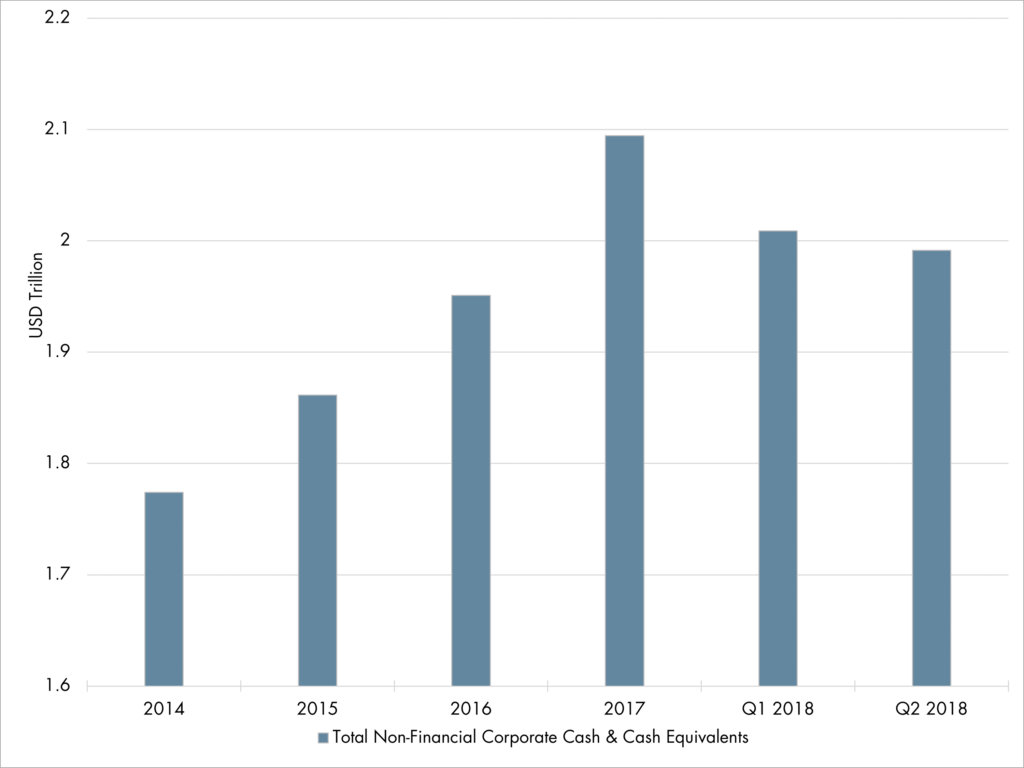
Source: Federal Reserve, Financial Accounts of the United States – Z1
Figure 3: The Trend in Capex Plans Has Moderated in Recent Months

Source: WSJ The Daily Shot, Morgan Stanley Research
These potential headwinds, coupled with a strengthening dollar and indications of tapering growth abroad, may be driving a moderation of market expectations with regards to future corporate performance (Figure 4). Recent market gyrations could also partially be reflecting that worry (Figure 5).
Figure 4: Tax Bump – Change in S&P 500 Earnings from a Year Earlier

Source: Bloomberg LP, Refinitiv
Figure 5: S&P 500
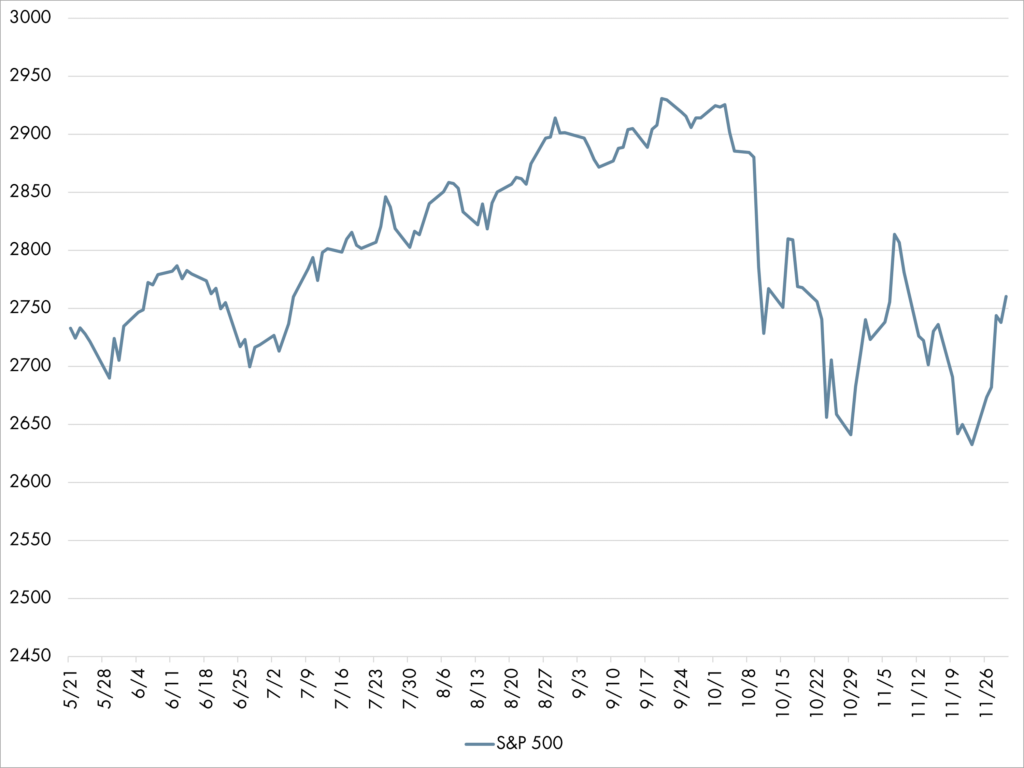
Source: FRED, S&P Dow Jones Indices LLC
An additional concern over increasing deficits relates to the rising portion of the budget that will be dedicated solely to interest payments (Figure 6). Interest payments on the national debt are expected to rise materially over the coming years, rivaling spending in healthcare and defense. This development has the potential to significantly hinder the government’s capacity to stimulate the economy in the next recession, which could increase its severity and/or duration given that the Fed is still in the process of normalizing monetary policy.
Figure 6: Federal Outlays, Interest as a Percentage of GDP

Source: WSJ, FRED, Labor Department via St. Louis Fed; congressional Budget Office
Monetary Policy
After years of unconventional monetary policy following the credit crisis, the Fed is now well along its tightening path. Over the course of the past two years, the central bank has raised its fed funds target seven times (with an eighth hike almost certain in December). The Fed has essentially met the goals of its dual mandate, with inflation recently reaching 2% and unemployment at a multi-decade low of 3.7%. Furthermore, wage growth hit a post-recession high of 3.1% in October, suggesting diminishing labor market slack may finally be flowing through to compensation levels (Figure 7).
Figure 7: U.S. Labor Statics
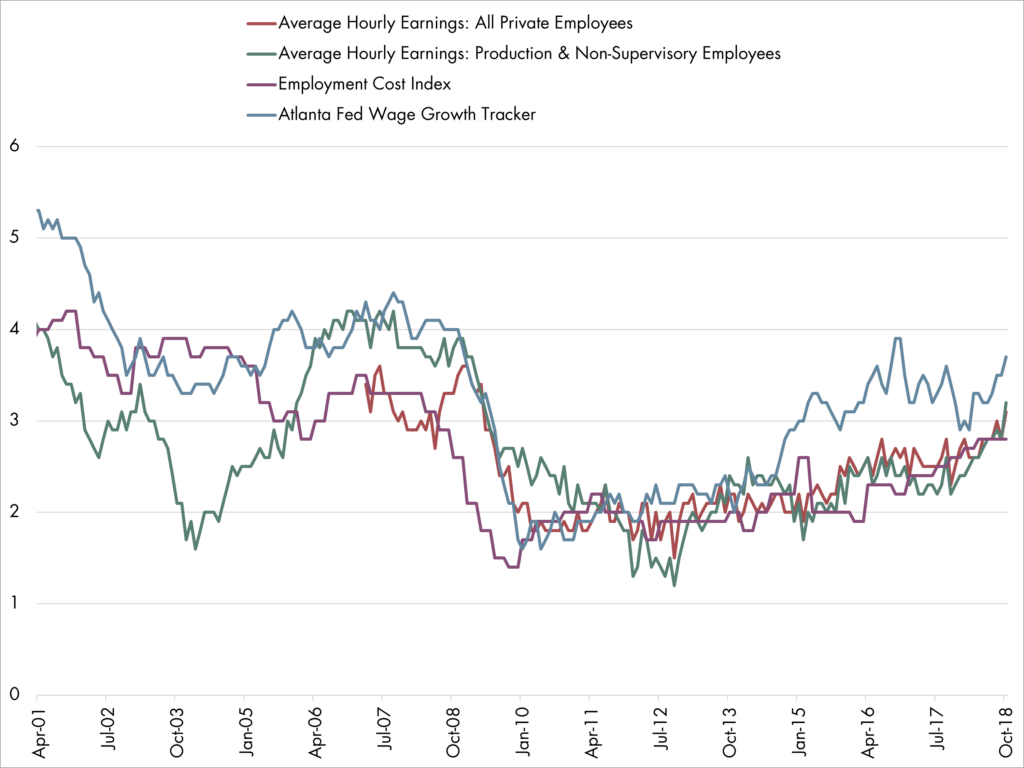
Source: Bloomberg, Bureau of Economic Analysis, Bureau of Labor Statistics, Atlanta Fed
Looking forward, the majority of Fed officials are projecting an additional 3-4 rate hikes next year, according to the most recent Summary of Economic Projections. This would take the fed funds rate above Fed officials’ estimate of the “neutral” rate (at which point policy is no longer stimulative). FOMC officials have recently played down the importance of both internal projections and the neutral rate, choosing instead to focus on incoming economic data to gauge the stance of policy. Nevertheless, overtly hawkish statements by Fed officials (e.g. when Chair Powell stated that rates were a “long way from neutral”) have led to outsized swings in financial markets. Goldman Sachs’ Financial Conditions Index (FCI) recently hit its highest level since early 2017 due to the combination of rising interest rates, a stronger dollar, and a declining stock market (Figure 8).
Figure 8: Goldman Sachs FCI

Source: Bloomberg, Goldman Sachs
Goldman’s Chief Economist Jan Hatzius estimates that this recent tightening of financial conditions could produce a drag of about 0.5% on GDP growth in 2019, while former Obama Council of Economic Advisers Chair Jason Furman estimates that it’s akin to about two fed funds rate hikes. In essence, the market has moved ahead of the Fed.
This could in turn force the Fed to counter in a dovish direction, closer in line to what fed funds futures markets are projecting. Indeed, this may already be happening: minutes from the Fed’s November meeting indicated growing concern over tightening financial conditions, a weakening global outlook, and a slowing in “interest-sensitive sectors of the economy,” namely housing. More explicitly, many participants suggested that the language referring to anticipated “further gradual increases” in the fed funds rate should be removed from the Fed’s upcoming statements, reflecting increased uncertainty over the policy outlook.
Some of this uncertainty may lay to the upside. Despite the tightening of financial conditions, underlying economic data remains strong. Should the economy continue to see a falling unemployment rate, accompanied by 200K-plus monthly job growth, it seems reasonable to assume that it will experience some symptoms of overheating. In the short term, this could be inhibited by the sharp drop in commodity prices, specifically oil, which will put downward pressure on inflation. However, over the medium term this remains a concern given the Fed’s prior inability to steer the economy into a “soft-landing.” Periods of excessively easy monetary policy have tended to result in recessions which have prolonged impacts on the economy; see the Great Inflation of the 1970’s or the Housing Crisis in 2008. In order to avoid a similar occurrence this time around, the Fed needs to remain wary of risks to the upside, even as short-term risks to the downside have arisen.
In addition to the path for rates, there is some uncertainty regarding the size of the Fed’s balance sheet, as well as its implication for monetary policy and financial stability. The Fed is currently on the path towards shrinking its balance sheet from a peak of $4.5 trillion at the end of QE3 to just over $3.0 trillion by the end of 2020 (Figure 9).
Figure 9: FED Balance Sheet

Source: Financial Times, Fitch
However, doing so has presented the Fed with some operating challenges given the way it currently adjusts short-term interest rates. As reserves have declined, the Fed has lost more and more control over where the effective fed funds rate actually lies. Normally, its desire is for the fed funds rate to lie in the middle of its 25 bp target range, which is capped by the rate it pays on bank reserves (Interest on Excess Reserves). But, as reserve levels have declined, the fed funds rate and IOER have essentially merged (Figure 10).
Figure 10: Short-Term Rates
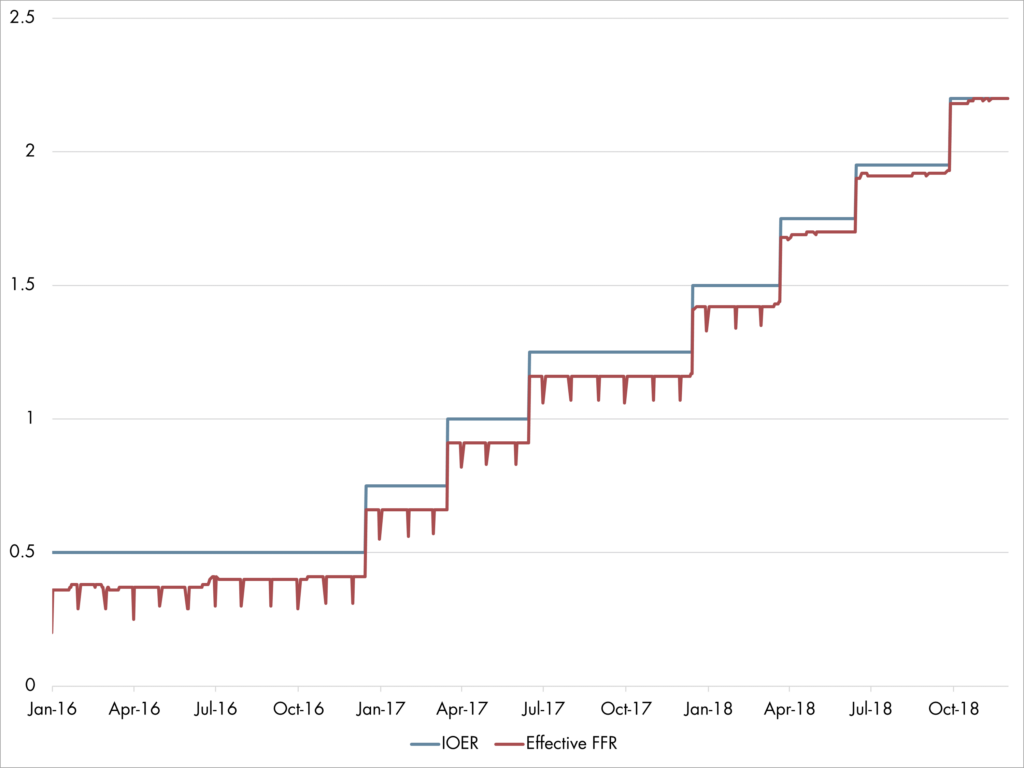
Source: Bloomberg, Federal Reserve
This problem is likely to worsen as reserve levels decline further, which leaves the Fed with a choice. On the one hand, it can continue letting assets run off its balance sheet back down to a “normal” level, which is based on currency in circulation. This would drain banks’ excess reserve levels, which could reignite activity in the now-dead overnight lending market. This in turn, could allow the Fed to return to its old way of operating in which it uses open market operations to target the fed funds rate directly.
On the other hand, the Fed could cease the run-off of its balance sheet, which would leave the system awash in reserves and maintain the Fed’s current system of targeting the fed funds rate by adjusting the IOER.
Each system has its advantages, both of which are linked to banks’ reserve levels. If the Fed were to drain the system of reserves, it would cease paying an effective subsidy to banks for parking their money. On the margin, this could improve economic efficiency, reduce political risk, and allow for an easier transmission of monetary policy to other short-term rates. However, it could also increase risks to financial stability, by reducing banks’ excess liquidity. Currently, banks are not overly reliant on credit markets for short-term funding, in large part because of their excess deposits with the Fed (Figure 11).
Figure 11: Liquid Assets Held by Banks & Short-Term Whole Funding of Banks

Source: Federal Reserve Financial Stability Report
Should banks’ reserve levels substantially decline, however, they could be forced back into overnight lending markets. This would raise the potential impact of a severe liquidity shock on bank funding operations.
This creates the need for a balancing act by the Fed. Recent FOMC statements suggest that they are leaning towards keeping some level of excess reserves in the banking system. On top of concerns over financial stability, this likely reflects the conservative nature of the Fed. The current system is working, in the sense that rates are rising, and the economy is adjusting. As such, the Fed may be loathe to take on more uncertainty by completely unwinding its balance sheet. Nevertheless, maintaining the current system may become even more precarious as rates rise, from both an operational and political perspective.
Currency
A side-effect of the Fed’s monetary policy normalization campaign has been its impact on currency markets. Rising interest rates in the US have contributed to an increase in the relative price of the dollar (Figure 12).
Figure 12: Trade Weighted U.S. Dollar Index – Broad
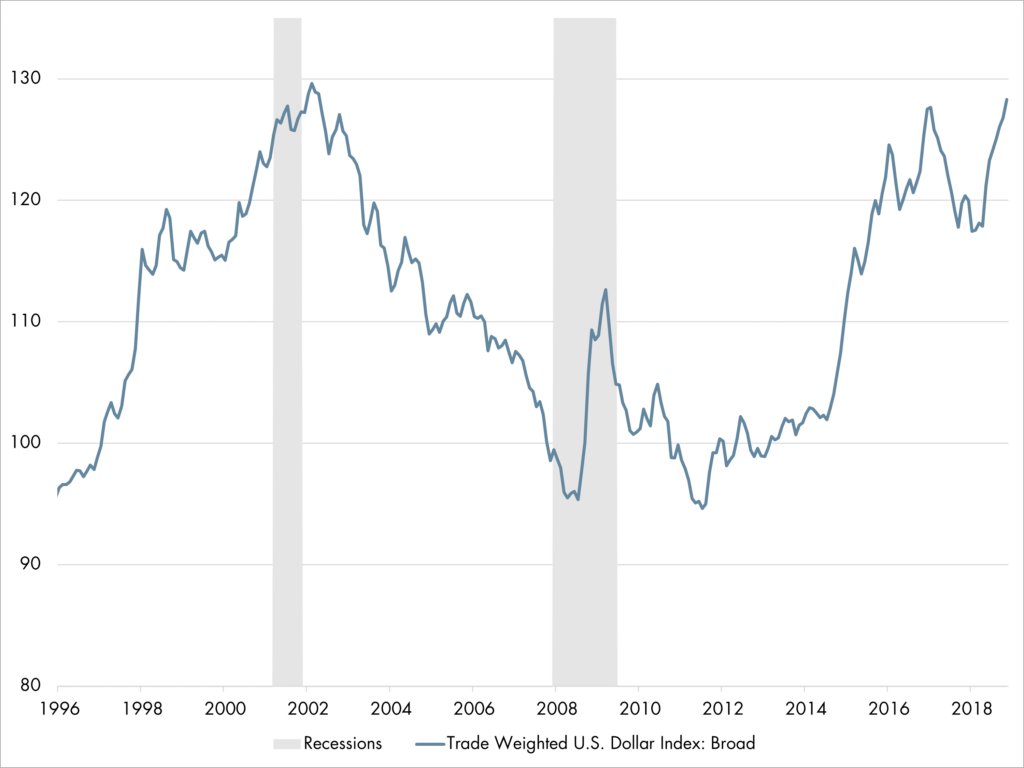
Source: FRED, Board of Governors of the Federal Reserve System
Moderating growth overseas, trade war concerns, and political risks in Europe have increased uncertainty over the global economic outlook and contributed to the rise. The recent increase in treasury issuance to fund the growing federal budget deficit further supports the currency’s current trajectory. Currency market expectations seem to imply that the dollar rally is not yet over (Figure 13).
Figure 13: Speculative USD Positioning Against Currencies in the CFTC CoT Report ($ bn)

Source: WSJ The Daily Shot, Haver Analytics, Goldman Sachs
A strengthening dollar impacts the investment outlook in several ways. First, by improving the terms of US trade, the ratio of export prices over import prices, it enlarges trade deficits while at the same time lowering imported goods’ inflation by rendering them cheaper (Figure 14). A higher trade deficit would detract from GDP growth, negatively impacting investor sentiment.
Figure 14: U.S. Trade

Source: Tradingeconomics.com
At the same time, a stronger dollar reduces overseas revenues for the largest multinational US companies through translational effects and loss of competitiveness vis-à-vis overseas firms. This could have a negative impact on US equity markets considering that approximately 40% of S&P 500 company earnings originate overseas. For example, Bank of America Merrill Lynch estimates that a sustained 10% increase in the EUR/USD exchange rate could result in a 3%-4% decrease in S&P 500 earnings per share.
Furthermore, higher rates in the US tend to attract capital from emerging markets, leading to higher interest rates in their domestic economies, which in turn may create difficulties for emerging market firms attempting to borrow or refinance debt. Underdeveloped domestic financial markets incentivize emerging market governments and corporates to borrow in dollars (what’s known as the “Original Sin”). As the dollar appreciates, corporations and governments holding dollar-denominated debt may be faced with higher interest payments, putting stress on their repayment capacity and raising the probability of default.
The impact of negative earnings surprises and distressed economic conditions abroad could damage investor sentiment and contribute to tighter domestic financial conditions. Investors should be cognizant of the strong dollar’s impact on corporate earnings and ensure their exposures in export driven sectors are stress tested.
Conclusion
As we head into 2019, the economy seems precariously positioned. Fiscal policymakers have stretched themselves thin by conducting overtly pro-cyclical policy, while monetary authorities are engaged in a high-wire balancing act between supporting the current expansion and preventing the economy from overheating. Trade policy remains highly uncertain, with the potential to boost or roil markets. A rise in corporate leverage, and with-it low-quality investment grade debt, portends the possibility of greater turmoil in credit markets should the cycle turn. Furthermore, a number of indicators, namely a flattening yield curve, rising wage growth, and pressure on emerging markets from a strong dollar, suggest that we are getting to the later parts of the business cycle. Given this backdrop, it makes sense for investors to analyze their positions and ask how secure they are if the cycle shifts. In the maturing stages of an expansion, it pays to be prepared.
DOWNLOAD FULL REPORT
Our research is for personal, non-commercial use only. You may not copy, distribute or modify content contained on this Website without prior written authorization from Capital Advisors Group. By viewing this Website and/or downloading its content, you agree to the Terms of Use.
Please click here for disclosure information: Our research is for personal, non-commercial use only. You may not copy, distribute or modify content contained on this Website without prior written authorization from Capital Advisors Group. By viewing this Website and/or downloading its content, you agree to the Terms of Use & Privacy Policy.
